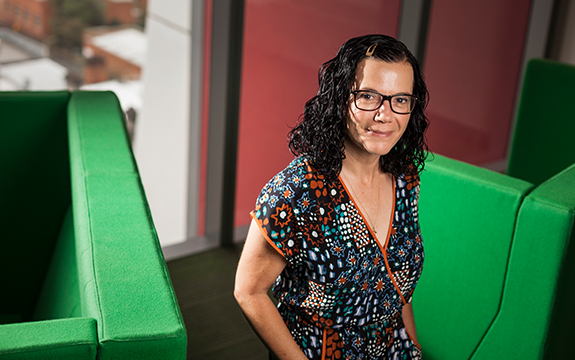Marngo Designing Futures program connects students to culture

In Summary
- This article originally featured in Swinburne’s Venture magazine
The Marngo Designing Futures program is named after the Woiwurrung word meaning “over there, in the future”. It’s a fitting moniker for a program that aims to attract Aboriginal and Torres Strait Islander students who identify with cultural heritage and traditions as a means of establishing careers in art, design and media.
The program was initiated in 2014 by Dr Samantha Edwards-Vandenhoek, senior lecturer and academic director (external engagement) in Swinburne’s School of Design, to address and better understand the reasons for low tertiary enrolments in design courses among Aboriginal and Torres Strait Islander students.
Marngo aims to develop relationships with Indigenous designers, educators, filmmakers and artists, and to deepen connections between Elders, Indigenous bodies, like-minded organisations and school communities.
The program receives support from Swinburne’s Student Equity and AccessAbility Services and Moondani Toombadool (the university’s Indigenous Engagement Team) and delivers on-campus workshops, inschool programs and design camps in Victoria and remote communities in Western Australia and the Northern Territory.
Powerful messages
Dr Edwards-Vandenhoek says the program has shown the power of place-based design education. “I think enabling young people to see how they can contribute to the development of their own communities can be an empowering process and mainstream education can lose sight of that.”
A week-long school workshop was held at Ramingining in Arnhem Land in September. Twenty-eight secondary school students joined a digital photography program that culminated in a vibrant street festival and photography exhibition at the Bula’bula Art Centre.
Other workshops held at Swinburne have been attended by students from the Melbourne Indigenous Transition School, Upper Yarra Secondary College, Gisborne Secondary College and more.
“(Aboriginal and Torres Strait Islander students) are enriching what we (universities) do by bringing their perspectives and knowledge.” And it’s quite specific.
“In Arnhem Land, English is often the third or fourth language in the Yolngu communities I work with. These young people have strong cultural connections and know who they are, so it’s quite amazing and powerful,” Dr Edwards-Vandenhoek says.
“But, in Victoria, some kids have only recently found out they have Indigenous heritage. They don’t know what that means and it makes them nervous. By introducing culture in a creative context, it is safe, fun and playful. Then design and art can be used to explore culture.”
The Marngo effect
Schools that take part in the Marngo program report a connection between participation and school attendance. Ngalangangpum High School at Warmun in Western Australia has integrated a design and technology curriculum, based on the “Marngo effect”. Its former principal, Leanne Hodge, says the students’ visual literacy, communication and teamwork skills showed improvement.
“While working on the intensive Marngo program, students expressed feelings of pride, satisfaction and accomplishment,” Ms Hodge says.
Making an impact
Marngo is deepening cultural connections and building leadership capacity in young people, Dr Edwards- Vandenhoek says. Three students at Victorian schools who have completed elements of the Marngo program have received state-governmentfunded year 12 Marrung Education Scholarships.
Plans are afoot to connect Marngo with online and face-to-face certificate-level courses in media and tourism at Swinburne. Dr Edwards-Vandenhoek is working with Swinburne in East Arnhem Land to provide opportunities for school students in ongoing design and media training through the region’s VET program.
“There has been success in how students feel about themselves. It has had a big impact on their cultural confidence, their pride and ability to talk about what culture means to them and test those waters.”
The word is already spreading like wildfire.

